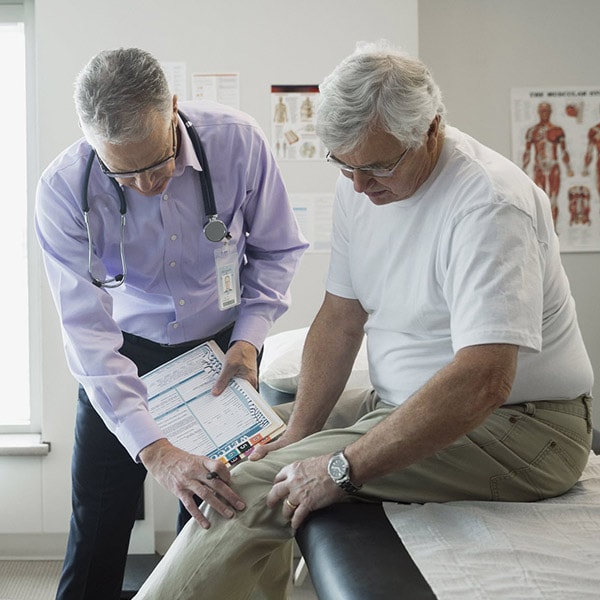Knee replacement due to osteoarthritis isn’t usually considered an urgent procedure.
Most people with osteoarthritis try a range of non-surgical options to relieve their discomfort and possibly delay having their knee replaced. Here are some you can consider, in conjunction with your doctor.
Exercise
Strengthening and aerobic exercises can be effective at reducing pain and increasing function. A graded exercise program under the guidance of a healthcare professional is recommended. Aquatic exercise is particularly gentle on the joints and can include swimming, aqua aerobics or hydrotherapy.
Weight loss (if you’re overweight)
For each kilo of weight you lose, you reduce the load on your knee joint by 4 kilos. No wonder losing excess weight can improve things! Weight loss of 5% or more has been shown to dramatically reduce joint pain. It can also reduce inflammation in the body, which is now believed to be a risk factor for osteoarthritis.
Have a look at our 18-week Healthy Weight for Life weight loss program, which is specially designed for people living with osteoarthritis. It includes activity and portion-controlled eating plans, online tracking plus support via phone, SMS and email. The program is free to eligible HCF members with hospital cover.
The Healthy Weight for Life program can also be used to improve your fitness before knee replacement surgery.

Knee taping
Taping up your knee can provide considerable pain relief. A physiotherapist can show you the correct way to apply the tape. You can apply tape before painful activities, such as exercise, but the tape can be left in place for days to weeks depending on adhesion durability.
Walking with a stick
Walking with a stick on the opposite side to your affected knee can reduce the load transmitted through the joint, reducing pain and improving function. A physiotherapist can help you learn how to use a stick for maximum benefit.
Topical medications
Rubbing a pain-relieving gel into the area around your painful knee can relieve osteoarthritis pain and carries less risk of side effects compared to oral medications. Commonly available analgesic gels contain ibuprofen, diclofenac or methyl salicylate.
Oral medications
There are several oral medications that can help reduce pain and improve function in knee osteoarthritis. Chances are you’ve already tried paracetamol.
Your doctor may also have recommended or prescribed a non-steroidal anti-inflammatory agent (NSAID). Common NSAIDs have the generic names aspirin, meloxicam, celecoxib, ibuprofen, mefenamic acid, diclofenac, naproxen, piroxicam and ketoprofen. They can cause gastric side effects and you should consult your doctor before trying them if you have any other health conditions.
More powerful analgesics containing opioids such as codeine, oxycodone, morphine or tramadol can be prescribed but they’re not recommended for long-term use due to their side effects, toxicity and potential for addiction.

Injectable medications
A corticosteroid injected into a painful knee can help reduce swelling and stiffness on a temporary basis.
Hyaluronic acid is an injectable substance that's also been proven effective. It’s made from a substance called hyaluronan. Hyaluronic acid can help restore the shock-absorbing effect of the fluid within the knee. This can reduce pain. Most people experience the greatest amount of relief with hyaluronic acid 6–12 weeks after beginning treatment.
Radiofrequency neurotomy (also known as radiofrequency ablation) is a relatively new procedure in which signals from the pain-transmitting nerves are interrupted, resulting in pain relief. While it doesn’t fix the underlying problem, it can bring pain relief that lasts between 6 months and 2 years. It’s normally done as a day surgery procedure and typically has a very short recovery period.
Non evidence-based treatments
You may have heard about the following treatments, but, to date, evidence of their effectiveness is lacking.
Supplements like glucosamine and chondroitin are commonly used by people with osteoarthritis but there isn't currently enough evidence to support their use.
Platelet-rich plasma injection is used to relieve osteoarthritis pain. Blood is collected from your arm and spun in a centrifuge to extract the platelet rich plasma. It’s then injected into the joint. There's little evidence it's effective at relieving joint pain.
Stem cell therapy is a treatment where your own stem cells are harvested (usually from fatty tissue) then extracted and injected into the joint. In the joint, stem cells can theoretically turn into cartilage cells to replace those damaged by osteoarthritis.
Stem cell therapy is still in its infancy, and relatively unproven, but several practitioners already offer it in Australia. It's currently expensive. A simpler, off-the-shelf stem cell product is currently undergoing clinical trials in Australia.
Experimental treatments should only be tried under strict medical supervision, such as in the context of a clinical trial. HCF doesn't cover experimental treatments or procedures. Before undertaking any procedure or taking any new medication, be sure to consult your regular healthcare practitioner.
weight management before surgery
Join HCF's weight management program and reduce osteoarthritis pain.